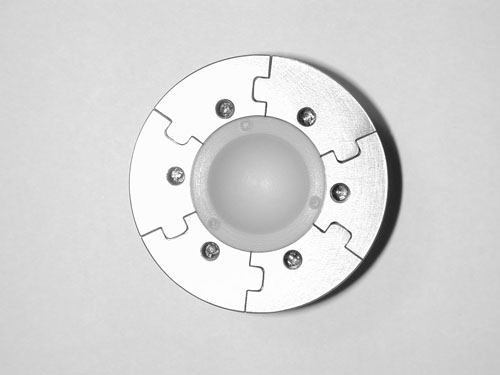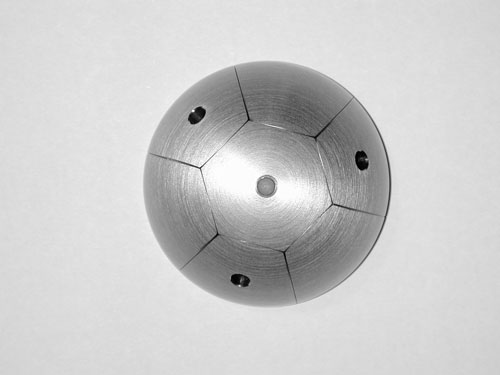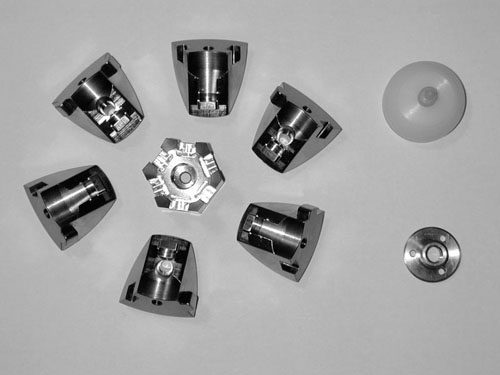Orthopedic Implants
Total Hip Joint Replacement Utilizing a Minimally Invasive Surgical Approach
Collaborator: Ory Keynan, MD
As a rule, open orthopedic surgical procedures, generally require extensive traumatic surgical dissection with subsequent disruption of muscular envelope, leading to prolonged post-operative rehabilitation and hospitalization to restore functions of these muscles. Minimally invasive procedures, on the other hand, greatly reduce trauma to surrounding tissue, provides for faster rehabilitation, more cosmetically pleasing results, and lower infection rate-all contributing to accelerate recovery, and reduce costs. In the case of a total hip joint replacement (THR), the major cost benefits are achieved through reducing post surgical hospitalization from an average of 6 days when an open procedure is used, to only 1 day when minimally invasive surgery is utilized.
A prototype implantfor THR was developed along with the surgical tools, and the surgical technique for minimally-invasive. Utilizing only two keyholes, the implants are inserted into the hip joint and expanded in place internally. While THR is the current focus, the concept is applicable to other joints, as well as to other surgical procedures, such as fracture fixation surgery.
The implant for performing total hip joint replacement using minimal invasive technique (40mm incision vs. 200-300mm) comprises of a socket, a stem, and a unique set of tools.
The modular cup is a 52 mm Titanium sphere (dome) configured to allow insertion of the modular shell piece-by-piece trough the 27mm access hole. The shell is then reassembled inside the body and locked to create a single integrated dome. The joints between the various shells' elements preserve the integrity of the shell under the biomechanical loads.
The shell includes specific holes that accommodate orthopedic screws for attaching the shell to the acetabulum (the anatomical socket of the pelvis). Since the shell has an incremental radial symmetry, the surgeon has the freedom to select the location of the holes with respect to the acetabulum for optimizing the screws location.
The outer surface is covered with Titanium rough layer to allow bone growth in to the shell for perfect integration with the bone. The inner surface of the shell incorporates a 27mm polyethylene cup. The cup is screwed and locked with a retaining ring into the shell. Special grooves and tabs were created at the interface between the shell and the cup to ensure solid connection between them avoiding micro movements.
The implant stem includes two sub structures: The body and the telescopic stem. The body is shaped as a cylinder made from Titanium with a varied diameter including the head (ball) interacting with the socket for creating the artificial ball/socket hip joint. Incorporated into the body are linked telescope that further creates the implant's stem.
The telescopic stem in its collapsed configuration is totally incorporated into the body. This configuration allows inserting the body with the collapsed stem into the femur bone through the 27mm hole. A special tool is then used to expend the telescope by screwing in the telescopic links into the femur bone through the second access hole – the 6 mm hole. The internal and external tread created in each telescopic link incorporated self locking mechanism. In addition, the tread direction (left / right) is different for the left and the right leg. This difference is aimed to make sure that under the biomechanical loads the tendency will always be to screw the implant into the bone and not vice versa. For specific anatomy that require long stem (longer then the one that is incorporated into the stem’s body) additional link with various length can be inserted through the second 6 mm access hole to accommodate the required overall stem’s length.

The THR implant stem and cup

The THR implant cup (bottom)

The THR implant cup (top)

The THR implant cup Disassembled
Surgical Procedure
Step 1
Step 2
Step 3
Step 4
Final Overview
Related Projects
![]() Ilio Lumber Fixation Device
Ilio Lumber Fixation Device
![]() Intra Vertebral Implant
Intra Vertebral Implant
![]() Palvic Plate
Palvic Plate